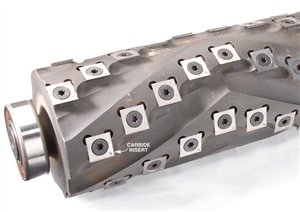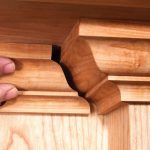We may receive a commission when you use our affiliate links. However, this does not impact our recommendations.
Cut manufactured materials and make fewer knife changes.
by Dave Munkittrick
The latest thing in jointers is the segmented carbide insert cutterhead. Instead of high-speed steel (HSS) knives, the cutterhead is peppered with an array of solid-carbide inserts (photo at right). During our 8-in. jointer tool test (see “Tool Test: 8-in. Jointers,” page 52), we had a chance to compare these new cutterheads head-to-head with their straight-knife cousins. We like what we saw and now use some of them in our shop. They’ve received unanimous thumbs-up from all users. Carbide took over in a hurry when it was introduced on saw blades, router bits and shaper knives. I wouldn’t be surprised to see the same trend occur with jointer and planer knives.
|
Cost
At $300 to $400, segmented carbide cutterheads aren’t inexpensive. But consider the cost of sharpening HSS knives (about $15 a set) and the need for an extra set of knives to replace the ones being sharpened (about $30). On average, the initial additional expense of a segmented carbide cutterhead is about the same as the cost for 20 HSS knife sharpenings, so you’ll eventually recoup your investment on the carbide model. With a segmented cutterhead, you basically pay up front for sharpenings but you get to enjoy all the benefits of carbide right away.
Replacing the inserts after all four edges are dull will cost $120 to $200, depending on the number of inserts in the head and the cost of each insert.
Changing Inserts
Rotating or changing the inserts is a somewhat tedious but straightforward task. You must be meticulously clean when changing or rotating inserts. Even a little sawdust under one insert can leave an uneven cut.
Segmented Cutterheads Take More Power
I’ve noticed that the segmented cutterheads take more feed pressure and demand more horsepower from the jointer. According to Curt Wilke of Wilke Machinery, which distributes several brands of jointers, this is because the segmented cutterhead always has several inserts cutting at any given time. A standard straight knife has an impulse cutting action. Each knife takes its cut with a rest period between.
5 Big Advantages
1. Longevity
A single set of carbide inserts will outlast a conventional knife set by approximately 40 times. That’s because each insert is made of solid carbide and has four cutting edges. Each edge will last up to 10 times longer than a typical HSS knife-edge. Multiply that number by the four edges on each insert and you get 40 conventional knife sharpenings built in to each set of carbide inserts. Remember that when you’re weighing the extra cost of a segmented carbide cutterhead.
2. Jointing Manufactured Materials
Carbide inserts allow you to joint manufactured materials, such as melamine and MDF, which would instantly dull HSS knives (photo at left). This is true of hard abrasive woods like teak, too.
3. Easy Knife Changes
With carbide inserts, knife changes are no longer such an onerous task (photo, page 62). No more fussing with knives that creep out of position as they’re tightened down.
4. Less Noise
A segmented cutterhead runs noticeably quieter than a straight knife cutterhead. Anything that diminishes the noise pollution in the shop is a welcome addition.
5. Quality of Cut
Carbide inserts will make clean cuts much longer than HSS knives will. We found that both carbide inserts and HSS knives make beautiful cuts when the knives are sharp. However, the performance curve drops off rapidly with the HSS knives simply because they dull more quickly.
|
A segmented carbide cutterhead has 40 to 60 individual carbide inserts bolted onto it. Each insert has four sharp edges that can be rotated when one side becomes dull.
Carbide cutters allow you to joint abrasive manufactured materials, such as plastic laminate, melamine, particleboard and MDF. These materials would destroy the edge on a set of HSS knives.
Changing carbide inserts is done less frequently and is less frustrating than with HSS straight knives. It still takes time, about a minute per insert, but with none of the headaches that come with setting straight knives. Just unbolt an insert, clean off any pitch, rotate the insert 90 degrees to a fresh edge and bolt it back into place. If you get a nick in the cutterhead, move a few of the nicked inserts to new locations. The cuts overlap and will clean up nicks in any individual insert. |
This story originally appeared in American Woodworker September 2005, issue #116.
Source information may have changed since the original publication date.

Here are some supplies and tools we find essential in our everyday work around the shop. We may receive a commission from sales referred by our links; however, we have carefully selected these products for their usefulness and quality.












